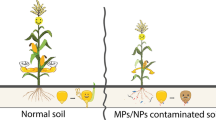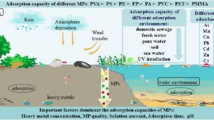Abstract
Environmental risk assessment of sites contaminated with chemicals needs to also consider mixtures of chemicals as these toxicants act more differently in a mixture than when they occur alone. In this study, we describe, for the first time, the use of a full factorial design experiment to evaluate the toxicity of a quaternary mixture comprising two polycyclic aromatic hydrocarbons (PAHs; benzo[a]pyrene (BaP) and phenanthrene (Phe)) and two heavy metals (cadmium (Cd) and lead (Pb)) toward a soil microalga, Chlorococcum sp. MM11. Biomass, in terms of cell number, and proline accumulation were used to evaluate toxicity responses. Factorial analysis of the data revealed statistically significant interaction effects between the mixtures of toxicants on 96-h biomass endpoint, while no significant interaction effects were observed on proline accumulation in the microalga. A comparison of the data on the toxicity of individual chemicals and those of the factorial main effect analysis clearly showed that Cd is more toxic to the alga, followed by BaP, Pb, and Phe. There was a substantial heavy metal accumulation and PAH degradation by the strain MM11 at EC10 and EC50 of the chemical mixtures.






Similar content being viewed by others
References
Axelsson L (1988) Changes in pH as a measure of photosynthesis by marine macroalgae. Mar Biol 97:287–294
Backhaus T, Arrhenius Å, Blanck H (2004) Toxicity of a mixture of dissimilarly acting substances to natural algal communities: predictive power and limitations of independent action and concentration addition. Environ Sci Technol 38:6363–6370
Baścik-Remisiewicz A, Aksmann A, Żak A, Kowalska M, Tukaj Z (2011) Toxicity of cadmium, anthracene, and their mixture to Desmodesmus subspicatus estimated by algal growth-inhibition ISO standard test. Arch Environ Contam Toxicol 60:610–617
Bates LS, Waldren RP, Teare ID (1973) Rapid determination of free proline for water-stress studies. Plant Soil 39:205–207
Bradford M (1976) A rapid and sensitive method for the quantitation of microgram quantities of protein utilizing the principle of protein-dye binding. Anal Biochem 72:248–254
Branco D, Lima A, Almeida SFP, Figueira E (2010) Sensitivity of biochemical markers to evaluate cadmium stress in the freshwater diatom Nitzschia palea (Kützing) W. Smith. Aquat Toxicol 99:109–117
Chan SMN, Luan T, Wong MH, Tam NFY (2006) Removal and biodegradation of polycyclic aromatic hydrocarbons by Selenastrum capricornutum. Environ Toxicol Chem 25:1772–1779
Deng WJ, Louie PKK, Liu WK, Bi XH, Fu JM, Wong MH (2006) Atmospheric levels and cytotoxicity of PAHs and heavy metals in TSP and PM2.5 at an electronic waste recycling site in southeast China. Atmos Environ 40:6945–6955
Echeveste P, Agustí S, Tovar-Sánchez A (2012) Toxic thresholds of cadmium and lead to oceanic phytoplankton: cell size and ocean basin-dependent effects. Environ Toxicol Chem 31:1887–1894
Fatma T, Khan MA, Choudhary M (2007) Impact of environmental pollution on cyanobacterial proline content. J Appl Phycol 19:625–629
Franklin NM, Stauber JL, Lim RP, Petocz P (2002) Toxicity of metal mixtures to a tropical freshwater alga (Chlorella sp.): the effect of interactions between copper, cadmium, and zinc on metal cell binding and uptake. Environ Toxicol Chem 21:2412–2422
García-Villada L, López-Rodas V, Bañares-España E, Flores-Moya A, Agrelo M, Martín-Otero L, Costas E (2002) Evolution of microalgae in highly stressing environments: an experimental model analyzing the rapid adaptation of Dictyosphaerium chlorelloides (Chlorophyceae) from sensitivity to resistance against 2,4,6-trinitrotoluene by rare preselective mutations. J Phycol 38:1074–1081
Gross W, Heilmann I, Lenze D, Schnarrenberger C (2001) Biogeography of the Cyanidiaceae (Rhodophyta) based on 18S ribosomal RNA sequence data. Eur J Phycol 36:275–280
Gustafsson JP (2011) Visual MINTEQ: a free equilibrium speciation model. KTH, Department of Land and Water Resources Engineering. http://www2.lwr.kth.se/English/OurSoftware/vminteq/contact.html. Accessed 20 March 2012
Haritash AK, Kaushik CP (2009) Biodegradation aspects of polycyclic aromatic hydrocarbons (PAHs): a review. J Hazard Mater 169:1–15
Hong Y-W, Yuan D-X, Lin Q-M, Yang T-L (2008) Accumulation and biodegradation of phenanthrene and fluoranthene by the algae enriched from a mangrove aquatic ecosystem. Mar Pollut Bull 56:1400–1405
Järup L (2003) Hazards of heavy metal contamination. Br Med Bull 68:167-182
Kamalakkannan R, Zettel V, Goubatchev A, Stead-Dexter K, Ward NI (2004) Chemical (polycyclic aromatic hydrocarbon and heavy metal) levels in contaminated stormwater and sediments from a motorway dry detention pond drainage system. J Environ Monit 6:175–181
Kamo M, Nagai T (2008) An application of the biotic ligand model to predict the toxic effects of metal mixtures. Environ Toxicol Chem 27:1479–1487
Ke L, Luo L, Wang P, Luan T, Tam NF-Y (2010) Effects of metals on biosorption and biodegradation of mixed polycyclic aromatic hydrocarbons by a freshwater green alga Selenastrum capricornutum. Bioresour Technol 101:6950–6961
Krishnamurti GSR, Megharaj M, Naidu R (2004) Bioavailability of cadmium–organic complexes to soil alga an exception to the free ion model. J Agric Food Chem 52:3894–3899
Lamaia C, Kruatrachuea M, Pokethitiyooka P, Upathamb ES, Soonthornsarathoola V (2005) Toxicity and accumulation of lead and cadmium in the filamentous green alga Cladophora fracta (OF Muller ex Vahl) Kutzing: a laboratory study. Sci Asia 31:121–127
Larras F, Bouchez A, Rimet F, Montuelle B (2012) Using bioassays and species sensitivity distributions to assess herbicide toxicity towards benthic diatoms. PLoS One 7(8):e44458
Leboulanger C, Quiblier C, Dufour P (2006) Rapid assessment of multiple-limiting factors of phytoplankton biomass: bioassays, in vivo chlorophyll-a fluorescence, and factorial design. Arch Hydrobiol 166:433–451
Lei A-P, Hu Z-L, Wong Y-S, Tam NF-Y (2007) Removal of fluoranthene and pyrene by different microalgal species. Bioresour Technol 98:273–280
Lu G, Wang C, Tang Z, Guo X (2007) Joint toxicity of aromatic compounds to algae and QSAR study. Ecotoxicology 16:485–490
Megharaj M, Kantachote D, Singleton I, Naidu R (2000) Effects of long-term contamination of DDT on soil microflora with special reference to soil algae and algal transformation of DDT. Environ Pollut 109:35–42
Mehta SK, Gour JP (1999) Heavy-metal-induced proline accumulation and its role in ameliorating metal toxicity in Chlorella vulgaris. New Phytol 143:253–259
Mei X, Wu Y-Y, Mao X, Tu Y-Y (2011) Antagonism of phenanthrene cytotoxicity for human embryo lung fibroblast cell line HFL-I by green tea polyphenols. Environ Pollut 159:164–168
Mielke HW, Wang G, Gonzales CR, Le B, Quach VN, Mielke PW (2001) PAH and metal mixtures in New Orleans soils and sediments. Sci Total Environ 281:217–227
Millington LA, Goulding KH, Adams N (1988) The influence of growth medium composition on the toxicity of chemicals to algae. Water Res 22:1593–1597
Ni L, Acharya K, Hao X, Li S (2012) Isolation and identification of an anti-algal compound from Artemisia annua and mechanisms of inhibitory effect on algae. Chemosphere 88:1051–1057
Olguín E, Sánchez-Galván G, Pérez-Pérez T, Pérez-Orozco A (2005) Surface adsorption, intracellular accumulation and compartmentalization of Pb(II) in batch-operated lagoons with Salvinia minima as affected by environmental conditions, EDTA and nutrients. J Ind Microbiol Biotechnol 32:577–586
Othman HB, Leboulanger C, Le Floc’h E, Hadj Mabrouk H, Sakka Hlaili A (2012) Toxicity of benz(a)anthracene and fluoranthene to marine phytoplankton in culture: does cell size really matter? J Hazard Mater 243:204–211
Perales-Vela HV, Peña-Castro JM, Cañizares-Villanueva RO (2006) Heavy metal detoxification in eukaryotic microalgae. Chemosphere 64:1–10
Pinto PDT, Litchman E (2010) Interactive effects of N:P ratios and light on nitrogen-fixer abundance. Oikos 119:567–575
Qian H, Li J, Sun L, Chen W, Sheng GD, Liu W, Fu Z (2009) Combined effect of copper and cadmium on Chlorella vulgaris growth and photosynthesis-related gene transcription. Aquat Toxicol 94:56–61
Ramakrishnan B, Megharaj M, Venkateswarlu K, Naidu R, Sethunathan N (2010) The impacts of environmental pollutants on microalgae and cyanobacteria. Crit Rev Environ Sci Technol 40:699–821
Ramakrishnan B, Megharaj M, Venkateswarlu K, Sethunathan N, Naidu R (2011) Mixtures of environmental pollutants: effects on microorganisms and their activities. Rev Environ Contam Toxicol 211:63–120
Ren S, Mee RW, Frymier PD (2004) Using factorial experiments to study the toxicity of metal mixtures. Ecotoxicol Environ Saf 59:38–43
Scarano G, Morelli E (2002) Characterization of cadmium– and lead–phytochelatin complexes formed in a marine microalga in response to metal exposure. Biometals 15:145–151
Shen G, Lu Y, Zhou Q, Hong J (2005) Interaction of polycyclic aromatic hydrocarbons and heavy metals on soil enzyme. Chemosphere 61:1175–1182
Subashchandrabose SR, Megharaj M, Venkateswarlu K, Naidu R (2012) p-Nitrophenol toxicity to and its removal by three select soil isolates of microalgae: the role of antioxidants. Environ Toxicol Chem 31:1980–1988
Szabados L, Savouré A (2010) Proline: a multifunctional amino acid. Trends Plant Sci 15:89–97
Tamura K, Peterson D, Peterson N, Stecher G, Nei M, Kumar S (2011) MEGA5: molecular evolutionary genetics analysis using maximum likelihood, evolutionary distance, and maximum parsimony methods. Mol Biol Evol 28:2731–2739
Thavamani P, Megharaj M, Krishnamurti GSR, McFarland R, Naidu R (2011) Finger printing of mixed contaminants from former manufactured gas plant (MGP) site soils: implications to bioremediation. Environ Int 37:184–189
Tran HL, Kwon J-S, Kim ZH, Oh Y, Lee C-G (2010) Statistical optimization of culture media for growth and lipid production of Botryococcus braunii LB572. Biotechnol Bioprocess Eng 15:277–284
Unsworth ER, Warnken KW, Zhang H, Davison W, Black F, Buffle J, Cao J, Cleven R, Galceran J, Gunkel P, Kalis E, Kistler D, van Leeuwen HP, Martin M, Noël S, Nur Y, Odzak N, Puy J, van Riemsdijk W, Sigg L, Temminghoff E, Tercier-Waeber M-L, Toepperwien S, Town RM, Weng L, Xue H (2006) Model predictions of metal speciation in freshwaters compared to measurements by in situ techniques. Environ Sci Technol 40:1942–1949
Vannini C, Domingo G, Marsoni M, De Mattia F, Labra M, Castiglioni S, Bracale M (2011) Effects of a complex mixture of therapeutic drugs on unicellular algae Pseudokirchneriella subcapitata. Aquat Toxicol 101:459–465
Vasseur C, Bougaran G, Garnier M, Hamelin J, Leboulanger C, Chevanton ML, Mostajir B, Sialve B, Steyer J-P, Fouilland E (2012) Carbon conversion efficiency and population dynamics of a marine algae–bacteria consortium growing on simplified synthetic digestate: first step in a bioprocess coupling algal production and anaerobic digestion. Bioresour Technol 119:79–87
Verbruggen N, Hermans C (2008) Proline accumulation in plants: a review. Amino Acids 35:753–759
Vighi M, Altenburger R, Arrhenius Å, Backhaus T, Bödeker W, Blanck H, Consolaro F, Faust M, Finizio A, Froehner K, Gramatica P, Grimme LH, Grönvall F, Hamer V, Scholze M, Walter H (2003) Water quality objectives for mixtures of toxic chemicals: problems and perspectives. Ecotoxicol Environ Saf 54:139–150
Walter H, Consolaro F, Gramatica P, Scholze M, Altenburger R (2002) Mixture toxicity of priority pollutants at no observed effect concentrations (NOECs). Ecotoxicology 11:299–310
Wang P, Luo L, Ke L, Luan T, Tam NFY (2013) Combined toxicity of polycyclic aromatic hydrocarbons and heavy metals to biochemical and antioxidant responses of free and immobilized Selenastrum capricornutum. Environ Toxicol Chem 32:673–683
Acknowledgments
SRS thanks the University of South Australia for the President’s scholarship and CRC CARE for the PhD scholarship.
Author information
Authors and Affiliations
Corresponding author
Additional information
Responsible editor: Robert Duran
Electronic supplementary material
Below is the link to the electronic supplementary material.
ESM 1
(DOCX 16 kb)
Rights and permissions
About this article
Cite this article
Subashchandrabose, S.R., Megharaj, M., Venkateswarlu, K. et al. Interaction effects of polycyclic aromatic hydrocarbons and heavy metals on a soil microalga, Chlorococcum sp. MM11. Environ Sci Pollut Res 22, 8876–8889 (2015). https://doi.org/10.1007/s11356-013-1679-9
Received:
Accepted:
Published:
Issue Date:
DOI: https://doi.org/10.1007/s11356-013-1679-9




